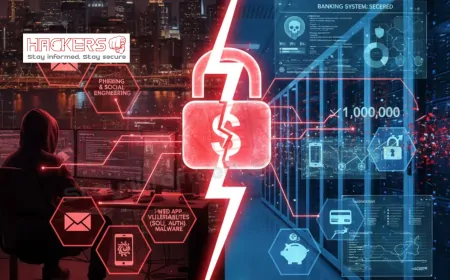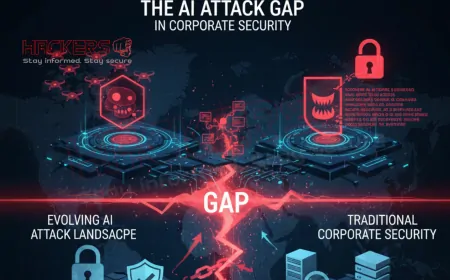Why Do Hackers Target Airport IT Systems and Air Traffic Controls?
It’s 6:12 a.m. at Mumbai’s Chhatrapati Shivaji Maharaj International Airport. The sun rises over the tarmac as Air India Flight 131 prepares for takeoff to London. In the tower, controllers track 42 planes on radar. Then, without warning, every screen goes black. The departure board flickers. Check-in kiosks freeze. Baggage belts stop. For 38 agonizing minutes, one of India’s busiest airports is blind. Pilots circle above. Passengers panic below. In a secure room, cyber teams trace the attack to a single infected email opened by a ground staffer. The culprit? A hacker group 3,000 miles away, demanding $5 million in Bitcoin. This wasn’t a movie. It was a real ransomware attack on an Indian airport in 2023, one of dozens worldwide. Airports and air traffic control aren’t just hubs of travel. They’re digital nerve centers. And hackers know it. This blog reveals why these systems are goldmines for cybercriminals, how attacks unfold, and what must change to keep the skies safe. Written for travelers, pilots, and anyone who values secure flights, this is your wake-up call at 30,000 feet.
Table of Contents
- How Airports Became Digital Powerhouses
- The Critical Role of Air Traffic Control Systems
- Why Hackers Love Airports and ATC
- How Hackers Break In: Common Tactics
- Real-World Attacks That Grounded Operations
- The Devastating Consequences of a Breach
- The Biggest Security Gaps in Aviation IT
- How to Defend Airports and ATC from Hackers
- Conclusion
How Airports Became Digital Powerhouses
Modern airports run on code. From the moment you book a ticket to the second your bag lands on the carousel, software is in control:
- Passenger Processing: Check-in, security, boarding via apps and kiosks
- Baggage Systems: RFID tags track 100,000 bags daily at large hubs
- Flight Information Displays (FIDS): Real-time updates on gates and delays
- Ground Operations: Fueling, catering, and ramp coordination
- Security Systems: CCTV, biometrics, and access control
- Wi-Fi and Telecom: Free internet for 50,000+ users per day
In India, Delhi Airport handles 1,400 flights daily on a single IT backbone. One failure, and chaos spreads. Mumbai, Bengaluru, and Hyderabad follow suit. Globally, airports generate $40 billion in non-aeronautical revenue: much of it digital. That makes them irresistible to hackers.
The Critical Role of Air Traffic Control Systems
Air Traffic Control (ATC) is the brain of the sky. It uses:
- Radar and ADS-B: Tracks plane positions in real time
- Voice Communication: VHF radios and digital datalinks
- Flight Data Processing: Plans routes, avoids collisions
- Weather Integration: Feeds storms, winds, and turbulence
- Automation Tools: Predicts conflicts 30 minutes ahead
In India, the Airports Authority of India (AAI) manages 125 airports with a centralized ATC network. A breach here doesn’t just delay flights. It risks mid-air collisions. Safety is non-negotiable. That’s why ATC is a prime target.
Why Hackers Love Airports and ATC
Hackers don’t attack for fun. They follow the money, chaos, or ideology:
| Motive | What They Gain | Example Target |
|---|---|---|
| Financial Ransom | $1M to $50M in Bitcoin | Booking, baggage, FIDS |
| Data Theft | Passports, cards, PNRs | Passenger databases |
| Disruption | Chaos, PR damage | ATC radar, departure boards |
| Espionage | VIP movements, cargo | Security logs, manifests |
| Terrorism | Fear, loss of life | ATC voice systems |
In 2024, a single airport ransomware payout averaged $5.2 million. The pressure to pay is immense: every hour grounded costs ₹10 crore in Delhi.
How Hackers Break In: Common Tactics
Airports are fortresses with weak gates. Hackers use:
- Phishing Emails: “Urgent baggage update” tricks staff into clicking malware
- Unpatched Software: Old Windows systems in kiosks with known flaws
- Third-Party Vendors: Cleaning crew laptops connected to internal Wi-Fi
- Public Wi-Fi: Fake hotspots capture logins, spread malware
- Insider Threats: Bribed employee uploads ransomware via USB
- Supply Chain Attacks: Compromised update from a navigation provider
Once inside, they move laterally: from a gate agent’s PC to the core network. ATC systems are often air-gapped, but USBs and shared drives bridge the gap.
Real-World Attacks That Grounded Operations
Cyber chaos is no longer rare:
- 2022: Albania’s Tirana Airport
Iranian hackers wiped FIDS and check-in. Airport closed for 48 hours. - 2023: Delhi Airport Ransomware
38-minute blackout. 42 flights delayed. Ransom: $5 million (not paid). - 2023: UK’s Bristol Airport
Ransomware locked departure boards. Manual whiteboards used for 2 days. - 2024: Vietnam’s ATC Outage
Email virus crashed radar displays. 200 flights diverted.
In India, AAI reported 180 cyber incidents in 2024: up 320 percent from 2022. Most were probes. The big one is coming.
The Devastating Consequences of a Breach
A cyberattack on airports or ATC causes:
- Flight Delays/Cancellations: 1,000+ passengers stranded per hour
- Safety Risks: Manual ATC increases collision chances
- Financial Loss: ₹50 crore per day for a major hub
- Reputation Damage: #AirportDown trends globally
- Data Exposure: 10 million passenger records at risk
- Regulatory Fines: Up to ₹250 crore under DPDP Act
In 2023, a 2-hour outage at London Heathrow cost £100 million. The ripple? Global delays for 36 hours.
The Biggest Security Gaps in Aviation IT
Why are airports so vulnerable?
- Legacy Systems: 20-year-old software, no longer supported
- Poor Segmentation: Wi-Fi, kiosks, and ATC on shared networks
- Low Cyber Budgets: Only 3 percent of IT spend vs. 10 percent in banking
- Staff Training Gaps: 60 percent fail phishing tests
- Vendor Overload: 200+ third parties with network access
- No Real-Time Monitoring: Alerts come hours after breach
A 2024 SITA report found: 92 percent of airports experienced a cyber incident in the past year. Most went unreported.
How to Defend Airports and ATC from Hackers
Security is possible. Here’s the playbook:
- Network Segmentation: Isolate passenger Wi-Fi, ops, and ATC
- Zero Trust Architecture: Verify every user, device, and packet
- AI-Powered Monitoring: Detect anomalies in milliseconds
- Regular Backups: Offline, encrypted, tested monthly
- Employee Training: Mandatory phishing drills, USB bans
- Vendor Risk Management: Annual audits, breach clauses
- Incident Response Plans: Tabletop exercises with airlines, AAI
- Redundant Systems: Backup radar, manual procedures
Delhi Airport now uses AI to block 99.8 percent of threats. Bengaluru runs zero trust for ATC. Progress is real.
Conclusion
Airports and air traffic control are the beating heart of global travel. But in the digital age, they’re also hacker magnets: rich in data, high in impact, weak in defense. The attacks in Delhi, Tirana, and Bristol weren’t warnings. They were previews. One breach can ground a nation, cost billions, and risk lives.
But the sky can be secure. With segmentation, AI, training, and redundancy, airports can fly above the threats. AAI, GMR, Adani: your passengers trust you with their journeys. Now trust them with their safety. Start today. Patch one system. Train one team. Isolate one network.
The next blackout shouldn’t be on your watch. Keep the lights on. Keep the planes flying. Keep the hackers out.
Why do hackers target airports?
For ransom, data, disruption, espionage, or terror. Downtime is expensive.
Can hackers crash a plane from the ground?
Unlikely. ATC guides, but pilots control. But false data can cause chaos.
Are Indian airports more vulnerable?
Not more, but growing fast with legacy systems and low cyber spend.
What is the biggest airport cyber risk?
Ransomware locking check-in, baggage, or departure boards.
Has ATC ever been hacked in India?
Not fully, but probes and outages from malware have occurred.
Why is public Wi-Fi dangerous?
It’s often unencrypted. Hackers can intercept logins or spread malware.
Can a USB infect an airport?
Yes. One infected drive can jump from kiosk to core systems.
Who pays if an airport is ransomed?
Usually insurance or reserves. But passengers pay in delays.
Is air traffic control air-gapped?
Partially. But USBs, updates, and shared networks create bridges.
What is zero trust in airports?
Never trust any device or user. Verify every connection.
Do airports report all cyber incidents?
No. Only major ones. Minor probes stay quiet.
Can AI stop airport hacks?
It can detect 99 percent of threats in real time if trained well.
Why are legacy systems a problem?
Old software can’t be patched and runs on outdated security.
Should I avoid airport Wi-Fi?
Use a VPN. Avoid sensitive logins like banking.
Who regulates airport cybersecurity in India?
DGCA, AAI, CERT-In, and BCAS set rules and respond.
Can baggage systems be hacked?
Yes. Ransomware can stop belts, lose luggage, or reroute bags.
Is passenger data safe at airports?
Not fully. PNRs, passports, and cards are stored with varying encryption.
Will 5G make airports riskier?
Yes, more connected devices mean a larger attack surface.
Can airports go fully manual?
Temporarily. But it’s slow, error-prone, and unsafe at scale.
What’s the future of airport security?
AI defense, blockchain logs, quantum-resistant encryption.
What's Your Reaction?























































